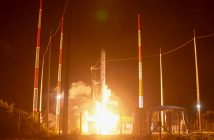
INTRODUCTION
General Kala: “Dispatch War Rocket Ajax!” (Universal Pictures, 1980)
The 1967 Outer Space Treaty broadly bans the stationing of Weapons of Mass Destruction in Outer Space, and prohibits military activities on celestial bodies (United Nations). The need to protect Space Infrastructure, or the massive surge of Human activity in Low Earth Orbit, Cislunar, and Mars Space raises the practical need for a type of patrolling and policing Spacecraft, painted in national livery, armed with defensive weapons to protect legitimate Space activity, operating in accordance with International Space Laws. This exploratory paper looks at the notion of a War Rocket: a Large Human and Robotically Crewed Armed Spacecraft based on past and current technology, using a current civilian hull prototype. However, it would be much heavier. Envisaged constructed using a thicker stainless steel hull, and have the same shielding as used on the International Space Station (ISS), mitigating potential weapon hits, in the same way that meteor and Space debris strikes are protected against. A War Rocket once launched from Earth initially, it would then remain in Space for decades. Lack of an underside heat shield would limit it to Moon, or Mars landings. Kept going by a program of life-extending hull, engine and systems upgrades. War Rockets, could be armed with lasers, recoilless solid projectile cannon, and missiles providing a full 360-degree protection radius creating Omnidirectional Defence.

“FIGURE 1: An imagined War Rocket manoeuvres near the Earth’s Moon.”
DYNAMIC ZONE SEPARATING AIRCRAFT AND SPACEPLANES
The notion of a War Rocket operating in Low Earth Orbit, Cislunar and Mars Space sits at the end of a continuum of thinking about the relationship between Space, and the Earth’s Atmosphere; and corollary to this the origin in the 1950s of the term: “Aerospace, in which various altitudes within – and beyond – the Atmosphere comprised a continuous Space.” (Sambaluk, 2011) Its beginning point, in the mid to late 1950s, the technology and Atmosphere – Space relationship was expressed in the following terms:
“We consider that Space is contiguous and an undivided medium with the Atmosphere. The requirement to operate above the Earth’s Surface is indistinguishable in our eyes, whether it be in the Atmosphere or above the Atmosphere. It is one medium as far as we see it from a military point of view.” (White, 1959; Sambaluk, 2011)
Rather than a conceptual continuum where an aircraft takes-off from the Earth’s Surface, and flies into Outer Space, a set of dynamic layers of Atmosphere above the Earth’s Surface, and weakening of the Earth’s gravity rapidly change the type of technology that can operate, transitioning from aircraft (air-breathing jet engine), balloon, rocket-plane (scramjet engines), and Spaceplane launched by a First-Stage Rocket Booster. Some technologies, such as the Scramjet Engine, technically a variant of a Ramjet airbreathing jet engine, are likely capable of reaching a very-high altitude (service ceiling), up to 47 miles: 250,000 feet: 76,200 meters, reaching the notional Edge of Space. The Edge of Space roughly corresponds to the Earth’s Mesosphere, generally at an altitude of 50 miles: 262,467 feet: 79,999 meters as the boundary; with its higher boundary-line set at 76 miles: 401,280 feet: 122,310 meters where Atmospheric drag becomes noticeable for a re-entering craft. Rather than a continuum as it was seen in the 1950s, a dynamic zone exists of several Atmospheric layers, beginning with conventional combat aircraft, or the higher-altitude Lockheed SR-71 Blackbird. Beyond the Low-Flight, and Mid-Stratosphere layers other technologies operate:
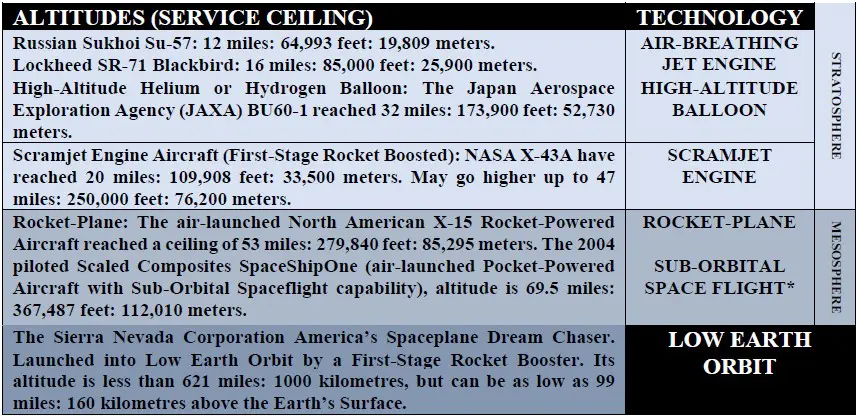
Sources: Flaherty, 2020; Various.
*Sub-Orbital Spaceflight: A rocket-powered aircraft reaches a point where its trajectory intersects with the Earth’s Atmosphere (and the notional Edge of Space). It will not complete one orbital revolution of the Earth (it does not become a Satellite), it does not reach escape velocity from the Earth’s gravity.
STRATEGIC-TACTICAL USE OF SPACE
The notion of a War Rocket operating in Low Earth Orbit, Cislunar and Mars Space sits at the end of a continuum of thinking about the Strategic-Tactical use of Space, in relation to the Earth’s Surface, and its Atmosphere. This is fundamentally a question of how technology changes, or creates a new strategic option. Answering this question requires looking at the original Strategic-Tactical use of the Boeing X-20 Dynamic Soarer: the Dyna-Soar.
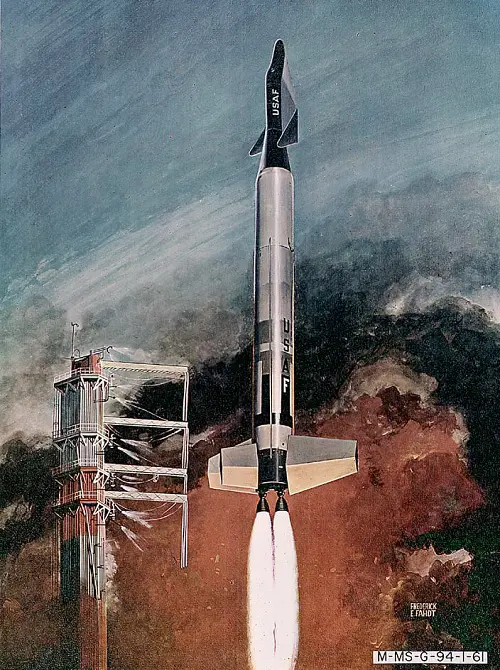
“A Dyna-Soar Space-Travelling Bomber launched by a Titan First-Stage Rocket Booster. (Source: NASA, 1961.)”
The Dyna-Soar use was largely seen, “as … a … future successor to the still new B-52.” (Sambaluk, 2011) Developed as, “[a]… manned hypersonic boost-glide rocket-propelled … aircraft” (Sambaluk, 2011). As a Space-Travelling Bomber it was intended to make Sub-Orbital Space Flight, or operate in Low Earth Orbit, returning to the Earth’s Atmosphere control gliding landing at an airfield. It was intended as the first U.S.,
“Space bomber … capable of circumnavigating the Earth at extreme altitudes and attacking its target with Space-to-Surface missiles.” (LeMay, 1958; Sambaluk, 2011)
The Dyna-Soar was an early craft based on First-Stage Rocket Booster launching. As a technology it opened the opportunity for a Planetary Strategy base on circumnavigating the Earth to be formulated.
The Dyna-Soar Strategic-Tactical use, largely allowed exploitation of the transitional region between the Earth’s Atmosphere (its Mesosphere Level) and the notional Edge of Space. This allowed the craft to work as a global bomber, carrying-out orbital bombing with a nuclear weapon loaded into Space-to-Surface missiles. Effectively this can be called a Planetary Strategy: circumnavigating the Earth, that is linked to the notion of, “control of high ground” (Sambaluk, 2011). However, at the same time in the 1950s, the same high-ground concept was also related to having a Lunar Base:
“The Moon provides a retaliation base of unequalled advantage. If we had a base on the Moon, either the Soviets must launch an overwhelming nuclear attack towards the moon from Russia two to two-and-one-half days prior to attacking the continental U.S. (and such launchings could not escape detection) or Russia could attack the continental U.S. first, only and inevitably to receive, from the Moon – some 48 hours later, sure and massive destruction.” (Boushey, 1958; Sambaluk, 2011)
The notion of a Lunar Strategy: the use of the Earth’s Moon, as a place to attack the Earth’s Surface or a potential source of military threat to the Earth’s Surface can be viewed as a Bi-Planetary Strategy. Originally conceived in the 1950s, this was seen largely as a punch, counter-punch set of exchanges, not unlike the two boxers fighting in the dark (Hart, 1920). The Bi-Planetary Strategy, however, postulates a third boxer in the dark (on the Moon), fighting alongside one of the two principal boxers in a match (the U.S. and Soviets on Earth).
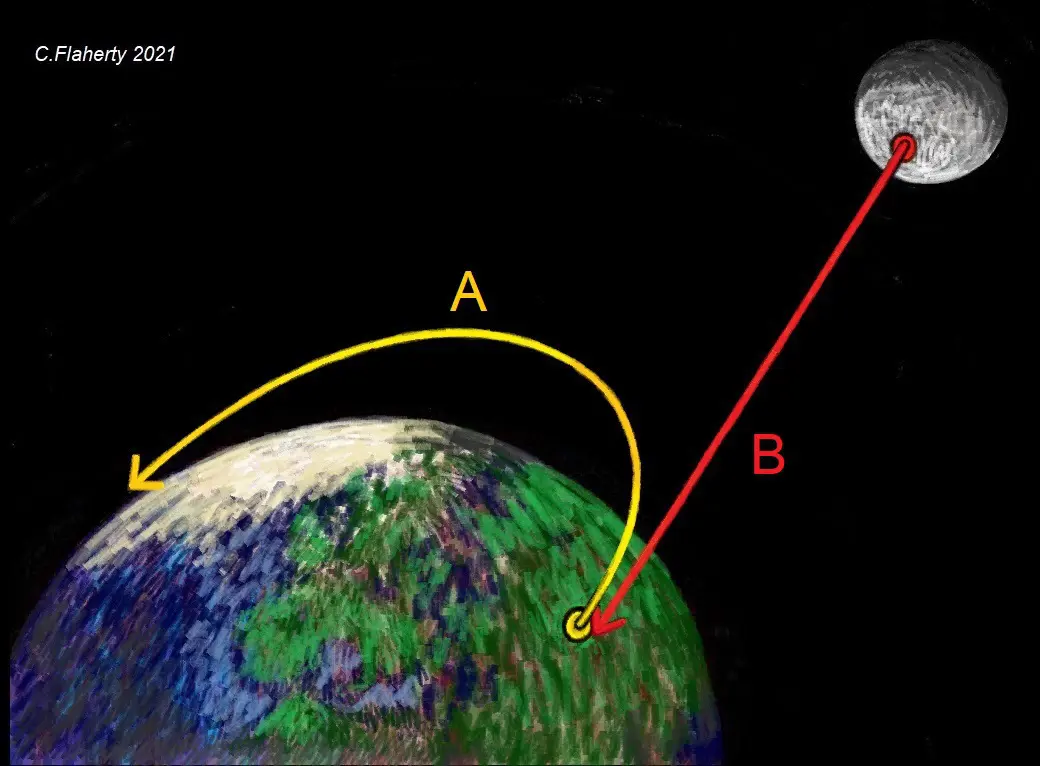
“FIGURE 2: Lunar Strategy. A Soviet nuclear first-strike on the U.S. (A). A U.S. counter-strike from a Lunar Base.”
FIGURE 2: A-B illustrates how the potential threat of a Soviet nuclear first-strike on the U.S. was effectively countered by a U.S. counter-strike from its Lunar Base. The original Lunar Base concept, its use a means of retaliatory-strike against an opponent on the Earth’s Surface, is a rudimentary Bi-Planetary Strategy. This is where there are two Earth Terrestrial-Based competitors, one or both relying on the Earth’s Moon used as a launch-point in Space, in much the same way as the Orbital Bomber notion uses a point in the Space high-ground to attack a location on the Earth’s Surface (a simple Planetary Strategy). A true (more complex) Bi-Planetary Strategy would be where a Moon Base-Settlement, operates as an entity in its own right. It should be noted, such a strategic concept does not exclude the notion that the Lunar Surface itself becomes a conflict zone between two armed groups of Soldier-Astronaut-Combatants (Flaherty, 2020). The same would apply to a Tri-Planetary Strategy if Mars operates as an independent Base-Settlement.
Further along the continuum beginning with a Planetary Strategy, a Multiworlds Strategy can be envisaged, including along with the Earth, Moon, and Mars, several other moons in the Solar System, or a Human occupied dwarf planet such as Ceres – the largest world at 596 miles: 960 kilometres wide, in the Asteroid Belt between Mars and Jupiter. It has been envisaged constructing a circular equatorial orbiting disk-shaped Megasatellite consisting of spinning habitats attached to a fixed frame connected to the planet by Space elevators (Janhunen, 2021). Other atmosphere worlds habitable for potential life include Europa (one of Jupiter’s Galilean moons), Titan, and Enceladus (Saturn’s moons), would also factor into a Multiworlds Strategy. Transition from a Planetary Strategy (the ability to circumnavigating the Earth), to a Multiworlds Strategy involves a growing set of relationships, beginning with the Earth and its Moon, expanding to include Mars, and then many other worlds in the Solar System:
| Earth Only | Planetary Strategy | Circumnavigating the Earth. |
| Earth – Moon | Bi-Planetary Strategy | Moon’s Lunar Base and the Earth’s Surface. |
| Three Worlds | Tri-Planetary Strategy | Earth, Moon, and Mars. |
| Many Worlds | Multiworlds Strategy | Earth, Moon, Mars, Europa, Titan, Enceladus, and Ceres. |
Technology Shift
A true Bi-Planetary Strategy, Tri-Planetary Strategy or Multiworlds Strategy entails the use of a War Rocket. In essence, the latter strategies development, where other worlds come into Strategic-Tactical play, is where a shift in technology create structural shifts in political relations as new options are now available (Havercroft, 2009). In this exploratory paper, the ability to develop a War Rocket is such a shift in technology. The War Rocket concept, is based on the notion that it is currently possible to build, as much of the technology have already been developed, for weapons, hull construction and hull armour. The other major shift, is the move from a Planetary Strategy which is the current state of Earth’s terrestrial international relations, and its relationship to Space, as this is encapsulated into the 1967 Outer Space Treaty; this broadly bans the stationing of Weapons of Mass Destruction in Outer Space, and prohibits military activities on celestial bodies (United Nations). The next major technology shift in Human and Robotic exploration in Space, and the massive shift to reliance on Space-Based Infrastructure that is about to occur, combined with the massive surge of Human activity in Low Earth Orbit, Cislunar, and Mars Space raises the practical need for a type of patrolling and policing Spacecraft, armed with defensive weapons to protect legitimate Space activity, operating within a new code of International Space Laws. Discussion as to how the 1967 Outer Space Treaty, and International Space Laws will likely change given new circumstances is beyond the scope of this exploratory paper. The following will seek to outline what a War Rocket might look like given past and current technology that is available to build such a craft.
THE WAR ROCKET: A CONCEPT DESCRIPTION
Entering into the region of Low Earth Orbit, Cislunar and Mars Space, it is envisaged in the near-future:
“The Space Force must be equipped with a fleet of responsive, Spacefaring vehicles under the operational purview of the Space Force’s equivalent of an Air Force colonel or Navy Captain.” (Bahn, 2020)
The basis of this exploratory paper is a notional War Rocket used for patrolling and policing to protect legitimate Space activity. This paper will seek to describe such a craft, using examples of pass and current technology. This section will look at the following design topics: five essential pillars; and long-time Space service. The section after this will look at the overall appearance of a notional War Rocket, its hull, size and livery. The sections following will look at hull armour issues, and consideration of weapons used potentially by a Spacecraft.
Five Essential Pillars
Future concepts for a patrolling and policing Spacecraft, used by a Space Force, “will need to focus on the four pillars of responsive launch: operability, reliability, affordability and dispatchability.” (Bahn, 2020) Additionally, it is argued, a patrolling and policing Spacecraft may have other requirements, such as: carrying defensive weapons; being armoured to withstand an attack; being large enough to carry supplies, such as fuel, in order to overcome the Delta-V limitation – a fifth essential pillar. A Spacecraft’s Delta-V is one of the major constraints in Space.
In broad terms, the momentum of a Spacecraft will continue to carry it forward indefinitely at a constant speed after the engines are turned off. For instance,
“Because objects in Space encounter negligible drag, Spacecraft can maintain extreme velocity without propulsion, enabling them to complete an Earth Orbit in as little as 90 minutes depending on orbital altitude.” (U.S. Space Force, 2020)
A Spacecraft is always orbiting something, and its flight path can be effected by its drift because of disturbances it encounters in Space, such as the pressure of sunlight on the hull over time pushing the Spacecraft off its course. For an interplanetary Spacecraft, its course is mostly set once the main engine burn is completed. Along its flight path it can make small corrections in its trajectory by firing small engines or thrusters. A Spacecraft can also rely on the gravity-assist it receives from a flyby of another planet or moon, to shape its next orbit.
The magnitude of a Spacecraft’s velocity change, provided by its onboard propellants, is known as Delta-V and is measured in meters-per-second (Reesman, 2020). If a Spacecraft drifts from its reference trajectory, a manoeuvre is needed to get it back on course. Delta-V is the measure of the energy needed to transfer from one orbit to another. Any manoeuvre in Space is measured by the amount of velocity change required. Delta-V stands for change in velocity, representing the direction and magnitude of the required change in the Spacecraft velocity which must be accomplished to get it back on course – which is expressed in terms of the amount of time required for an engine to be fired and produce thrust. A Spacecraft’s total Delta-V capability is constrained by the amount of propellant it can carry – which directly determines its size as a craft (this issue will be looked at in the next section).
Long-Time Space Service
The Boeing Stratofortress: the B-52, was made in 1952, and the youngest B-52 still in active service currently are close to 60 years old. Likewise the War Rocket could likely remain in Space for an even longer period of time, as long as its hull maintains its integrity and is maintained with upgrades and internal refits. In regards, to the current Space Fleets (discussed at the end of this paper), the concept of lifelong orbit has largely been accepted for Spacecraft:
“Once placed in orbit, most Spacecraft never return to Earth. Military Spacecraft are forward employed for the duration of their lifespan.” (U.S. Space Force, 2020)
A War Rocket after its construction and initial launch from Earth, will likely remain in Space, patrolling Low Earth Orbit, Cislunar and Mars Space. Its lack of heat shield protection (sacrificed in order to achieve near Omnidirectional Defence – discussed later in this paper) will likely restrict its landing capabilities to the Earth’s Moon, and possibly Mars for refits, maintenance, and resting its crews.
WAR ROCKET APPEARANCE
FIGURE 1: The notional War Rocket could be built using current Spacecraft and Space Station technology used in the past and currently. It would be a second stage craft with its own engines. Based on current civilian hull prototypes, its size can be envisaged, as a large-scale bullet ended cylinder some 50 meters: 160 feet, with a diameter of 9 meters: 30 feet, and a payload capacity of 100 tons. Launched from its Earth construction yard, by a Super Heavy Lift First-Stage Rocket Booster. The War Rocket is envisaged with a crew of perhaps around 20 Space Force Human and Robotic Guardians. The War Rocket needs to dock with other craft in Space, refuel in orbit (or in Space), change crew, act autonomously, using its Robotic Crew: some of which will be Bipedal Humanoid-Looking Astronaut Assistant Robots (Flaherty, 2020).
Sacrifice of an underside heat shield on a War Rocket, reflects its interior configuration, as the several crewed levels above its fuel tanks, will have its internal rooms looking outwards from all sides, giving a full 360-degrees spherical view of Space. Like the living end of the War Rocket it will have several domed turrets containing weapons, allowing for all-round observation and defence, from multiple directions in Space – this is based on the concept of Omnidirectional Defence (this issue will be discussed in the next section on weapons).
International Recognized Livery
FIGURE 1: Illustrates a notional War Rocket, showing it possibly painted in white and red livery. This is required, as such a craft would need to clearly identify its nation of origin under International Space Law. Founded in the Laws of War, which created the notion of the Astronaut-Combatant:
“A necessary precondition for any Astronaut claiming combatant status … As applied to Space Warfare, this might mean that a combatant who enters an opposing Spacecraft cannot be considered a spy as long as his vessel bears its prescribed distinctive markings, and the Astronaut wears his military uniform.” (Worden, 2002)
As stated, the War Rocket concept is based on defensively armed craft used for patrolling and policing protecting legitimate Space activity. It therefor does not need any type of camouflage – which may in fact add to heat problems. Spacecraft and the International Space Station (ISS) are usually finished in white, to better reflect most light, and reduce heat absorption by the craft. A white finish on the craft better aids visibility from afar against the blackness of Space. Coloured markings in various designs are also used officially by NASA to indicate various vehicle types (NASA).
HULL ARMOUR
It is envisaged that a War Rocket hull would be more heavily constructed from stainless steel to give the craft greater armour and structural strength. Using the current International Space Station (ISS), as an equivalent example its shielding mostly comes from attached materials to its hull, designed to withstand, “hypervelocity impacts … sufficient to cause a wide range of damaging effects.” (National Research Council, 1997) Treating potential weapon hits, in the same way that meteor and Space debris strikes are protected against. In regards to the International Space Station (ISS):
“[Its] … pressurized modules, for example, have multiple vulnerabilities to impact. Large enough meteoroids or debris striking a pressurized module at typical velocities will cause the module wall to spall or break off chips, sending pieces of the wall into the module, even if no air pressure is lost. If the wall is perforated, then particles of the impactor will also enter the module. While spallation particles are much slower than the originating impactor, they can be much larger. Both types of particles can cause injury or loss of life to the crew, as well as damage to internal components in the path of the projectile. Aluminium spallation particles (the ISS is primarily constructed of aluminium) can also burn quite actively, creating a fire hazard inside the module.” (National Research Council, 1997)
A key driver of the War Rocket’s armour is the 1965 U.S. Army study that looked at warfare on the Lunar Surface, which is equally applicable to conditions in Space, recognizing a complete redefinition of the enduring features of tactics:
“It should be kept in mind … that Penetration and Lethality on the Moon are almost synonymous since penetration of a pressurized vessel on the Moon may be tantamount to defeating it.” (U.S. Army, 1965)
Equivalence between Penetration and Lethality as a new tactical concept applied to pressurized structures that housed Humans in the Lunar Base, their Spacesuits, or Spacecraft would be identical to conditions in Space. The next section will look at weapons issues.
WEAPONS
A conceptual War Rocket would be armed with lasers, microrockets, and recoilless solid projectile launchers-firing guns. Whereas laser weapon technology is current, the weapons family of microrockets, and recoilless solid projectile launchers-firing gun dates from the 1960s, and were specifically conceptualized in order to deal with the problem of weapon recoil. So far there is only one known example of a cannon armed Spacecraft, the Soviet Almaz Space Station, “which carried an externally mounted machine gun cannon to defend against American astronaut attacks.” (Reesman, 2020) This weapon is understood to have not been recoilless, and its firing had the potential for shock and recoil,
“to damage the station but, in the vacuum of Space, those forces raised the possibility that shooting the weapon could send it flying in a dangerously unpredictable fashion … [the solution was]… ignited its jet thrusters simultaneously with firing the cannon to counteract the weapon’s powerful recoil” (Zak, 2015; Trevithick, 2021).
In reality, the Soviet Almaz machine gun cannon was unnecessarily over-gunned given orbital ballistics principles. A projectile need not be that large to be effective in the Space environment. Equivalence between Penetration and Lethality has the same level of threat relevance to a Spacesuit, Satellite, Spacecraft or the International Space Station (ISS).
As a general principle of Space Weapons Ballistics, a projectile performs in the exact same way as a Spacecraft. The momentum of a projectile will continue to carry it forward indefinitely at a constant speed after it is initially propelled. A projectile until it strikes a target, will have a reasonable straight trajectory until its flight path is effected by disturbances it encounters in Space. Otherwise, like a Spacecraft a projectile is always orbiting something. It also may be the case that a projectile firing gun or cannon may not need to be that large. As a projectile has roughly the equivalent of a micrometeoroid, it has a great deal of velocity, and hence impact force. For instance, currently in Earth Orbit, Space debris nuts and bolts, “travel at speeds up to 17,500 miles per hour, fast enough for a relatively small piece of orbital debris to damage a Satellite or a Spacecraft.” (Garcia, 2017) The following sub-sections will look at several handgun sized weapons designed for use on the Lunar Surface. All of these likely would have much greater impact by a standard bullet-sized projectile, of say one centimetre diameter in Space than on the Earth’s Surface; as the kinetic energy formular in a Space environment states: the velocity of a projectile in Space is squared translating into greatly increased energy.
It can be anticipated that achievable accurate weapons ranges in Space will be much greater than those traditionally experienced on Earth. The 1965 U.S. Army study looking at Lunar performance weaponry argued, “[the approach to]… the problem of Space weaponry should recognize the differences in … [Lunar] … conditions” (U.S. Army, 1965). The major tactics change posed by Lunar conditions, was largely unrestricted long ranges, and high visibility, largely negating the need for complex weapons sights. Long-range effective weaponry would create wide, long-range killing zones, that would force both offensive and defensive forces into highly distributed modes of operation. A tactical problem, is that whereas a patrolling War Rocket is highly visible, it would be likely vulnerable to a stealth and camouflaged opponent, laying in ambush in order to escape potential detection and destruction, and give the best possible tactical advantage potentially attacking and destroying a War Rocket.
As stated, the Equivalence between Penetration and Lethality in the Space environment is a major driver for how weapons are used. This problem of potential impacts threat could be negated potentially,
“mitigated or perhaps even eliminated … [by]… early detection and evasive manoeuvre … or … [in the]… class of midrange impactors … not covered by these strategies, one can use active near-range defence based on Kinetic Kill Vehicles or … lasers.” (Janhunen, 2021)
It is quite possible that part of the defences of a War Rocket could be smaller Kill Vehicle – Satellites that are deployed and operated away from the craft, by its crew.
It is anticipated the War Rocket will not have an underside heat shield, as the basic internal lay-out of the craft and its placement of weapons, control area, windows, and sensors will be all over the forward portion of the craft. Unlike traditional design of Spacecraft which have a distinct undersides, and topsides the design will follow-on as an extension of the basic principle of all-round defence of an aircraft. For instance, a Boeing B-29 Superfortress, and later B-36 Peacemaker, have multiple top side, tail, and belly mounted gun turrets and, “[this]… protective armament provided a full 360-degree protection radius while the bomber was in flight.” (Adams, 2009) Omnidirectional Defence is likely to drive initial War Rocket design using three-dimensional tactics concepts (Flaherty, 2010). This issue will be examined at the end of this exploratory paper.
Lasers
The laser armament on a War Rocket is likely to be its main cannon, and based on current laser weapon designs such as the one currently used by the U.S. Army Space and Missile Defense Command’s Directed Energy-Manoeuvre Short-Range Air Defense Stryker combat vehicles, these have the laser system integrated into the vehicle’s existing hardware (Keller, 2020). Additional to the War Rocket’s fuel and Engines systems it is likely it will have its own electrical power generator. Arming a War Rocket with a main laser weapon, is part of a more general trend towards favouring their use in Space-to-Space War (Harper, 2019). However, three problems are still current, power, weapon size, and craft movement:
“You’ve got to have the powerful laser, you’ve got to miniaturize it, and then you have to have the power source on your Satellite … obviously you don’t want it jittering or moving around and it has to be very precisely positioned to hit the target” (Harper, 2019).
Currently, there are number of land, and sea-based laser weapons, in development:
“The U.S. Army is developing its most powerful laser yet that is a million times more powerful than current systems. Most laser weapons fire a continuous beam until a target melts or catches fire, but the Tactical Ultrashort Pulsed Laser (UPSL) for Army Platforms will emit short, pulse-like bursts.” (Hambling, 2021)
The U.S. in-service (2014 till present) Laser Weapon System (LaWS), can shoot down Unmanned Aerial Vehicles at shorter ranges and blind the sensors at longer ranges (Team Crane, 2012). Installed on the USS Ponce AFSB(I)-15, from 2014 till 2017 (Dukowitz, 2017). A solid-state Laser Weapon System Demonstrator with a power level of 150 kilowatt (Freedberg, 2020), is currently fitted to the USS Portland LPD-27 (Commander, 2020). A Lockheed Martin version (2018 till present) Laser Weapon System is fitted to the USS Arleigh Burke DDG-51 (Laporta, 2018).
It is generally understood, the current U.S. Navy in-service Laser Weapon System (LaWS) have effective ranges of 1 mile: 1.6 km: 0.87 nautical miles (Team Crane, 2012). In a Space environment the range and effectiveness greatly changes. The general rule, is a laser in clear air or the vacuum of Space where nothing can interact with the light energy, the energy and momentum are conserved and can potentially travel forever (Spencer, 2020).
Microrockets
The 1965 U.S. Army study identified several plausible hand-held presumably smoothbore weapons options, with a much reduced recoil (equivalent to the Moon’s gravitational field which is notionally a sixth that of the Earth). A proposed short single barrel, “spin stabilized micro gun” (U.S. Army, 1965), worked on the Gyrojet projectile principle: firing by electrical ignition a small bullet round packed with its own propellent, that acted like a micro-rocket. It was assumed the Gyrojet projectile firing micro gun would have had sufficient muzzle velocity (calculated to be 3,000 feet per second), allowing a projectile fired from the horizontal, reaching its full-distance impact point some 8,190 feet: 2,500 meters away. A multi-barrelled version called a ‘sausage’ was also envisaged that fired by electrical ignition, a sabot capped flechette with its own propellent case. This weapon, like the Gyrojet projectile firing micro gun would have had a muzzle velocity calculated to be 3,000 feet per second, giving it the same range capabilities.
Recoilless Solid Projectile Launchers-Firing Guns
Mid-range weapons were envisaged, by the 1965 U.S. Army study, namely smoothbore pistols. One used a compressed spring to propel a spherical projectile, along with a ‘gas cartridge gun’, that relied on compressed gas to fire spherical projectiles. It was envisaged these guns had a muzzle velocity of 1,000 to 1,600 feet per second, giving a plausible range of somewhere in the vicinity of 2,624 feet: 800 meters (U.S. Army, 1965).
The 1965 U.S. Army study looking at Lunar surface weapons, identified these were to have largely limited magazine capacity, following a requirement to keep, “weapon weight at a minimum … [to reduce transport costs into Space initially].” (U.S. Army, 1965) Another weight limitation imposed on weapons design, was to keep these physically small and light-weight. Small arms intended for use by Soldier-Astronaut-Combatants, could be used for arming a War Rocket. While small-sized weapons, by terrestrial standards, these might be more than effective in a potential Spacecraft-to-Spacecraft engagement (discussed at the end), as the ballistics properties of a projectile propelled in Space have much greater lethality.
OMNIDIRECTIONAL DEFENCE
An approach based on, “[the]… general attributes of the Space environment” (Preston, 2002), identifies it as a vacuum, and boundless three-dimensional expanse where objects and events have relative positions and directions. In Physical Space this is the intersection of three linear dimensions. In biology, an organism exhibits spherical symmetry where its body is shaped like a sphere, and all parts are arranged or radiate equally around a central point. For example, the sea urchin display a type of Spherical – Omnidirectional Defence, in a three-dimensional medium – water. The sphere emerges as a Tactical Shape in Space, like the line, square, block, or triangle are all Tactical Shapes that have inherent tactical uses in Earth-Based Terrestrial Warfare traditionally (Flaherty, 2020). An example of current technology enabling a 360-degree spherical view of the tactical environment seeing through the aircraft structure, is the next technology development for the Lockheed Martin F-35 Lightning II Joint Strike Fighter (Keller, 2020). The AN/AAQ-37 Electro-Optical Distributed Aperture System has six high-resolution infrared sensors mounted around the airframe providing an unobstructed spherical coverage, sending this to the pilot’s helmet-mounted display.
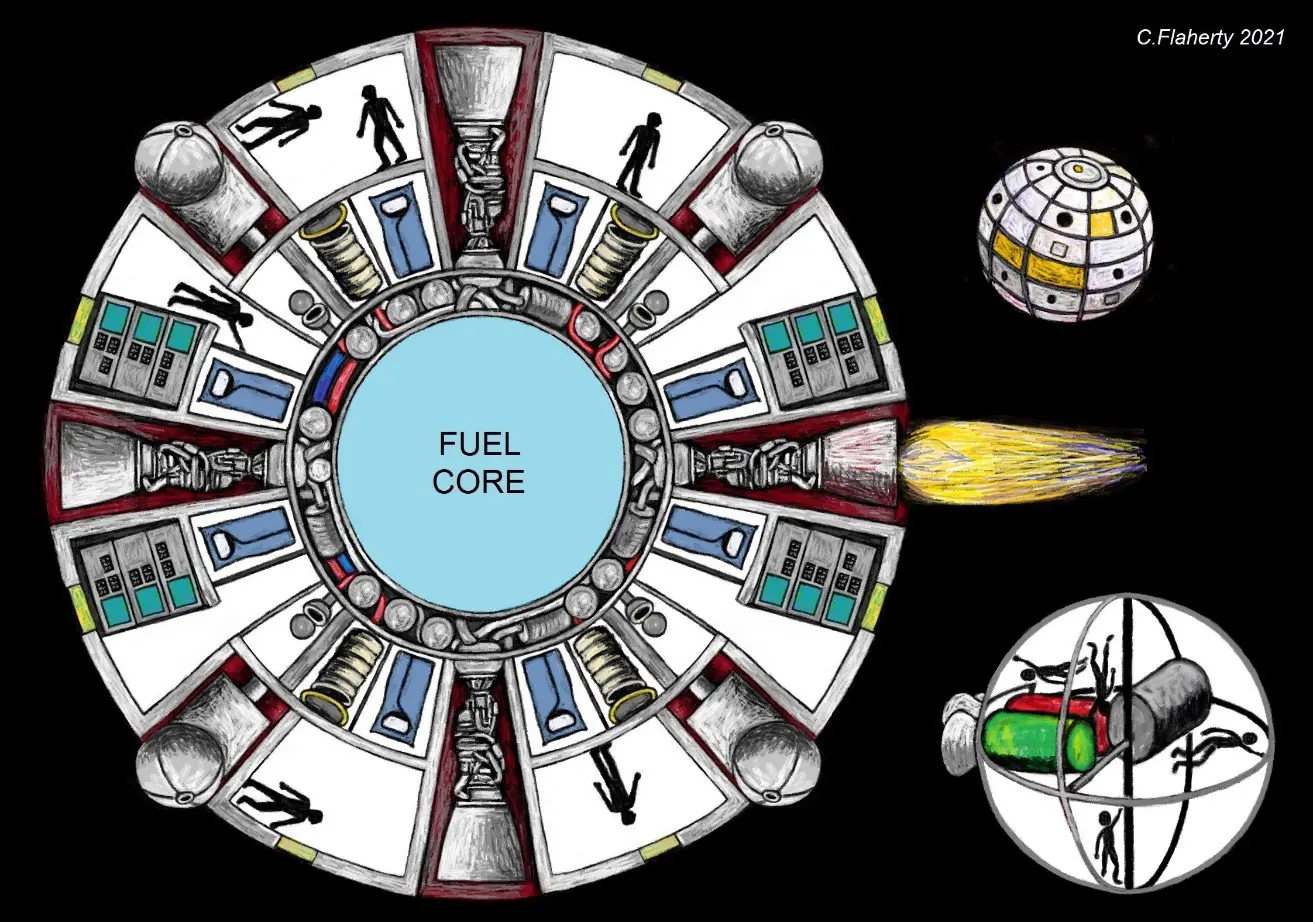
“FIGURE 3: An imagined cut away view of a Spherical Spacecraft. An exterior view and internal view of the Tsiolkovsky Spherical Spacecraft are also illustrated.”
FIGURE 3: Is an imagined craft based on the Tsiolkovsky Spherical Spacecraft, that envisaged its Human crew in orbiting weightlessness, with each occupant operating a facet controlling a different direction (Tsiolkovsky, 1883). The other influence for the Spherical Spacecraft is one known in Science Fiction writing, that had weapons mounted on each of the exterior quarters creating 360-degree spherical defence: Omnidirectional Defence (Smith, 1928). The illustration imagines a true Spherical Spacecraft having six rocket engines fed by a core placed outwards at the intersection of two hemispheres, each divided into four quarters. All the decks face outwards, with curving ceilings and floors, a reverse of the fictional carousel spinning band of deck shown in the Discovery One (Kubrick, 1968). We might envisage that Omnidirectional Defence as a concept impacts Spacecraft design allowing it to tactically manoeuvre, and use its weapons in any direction at once – this will be discussed next.
Spacecraft-to-Spacecraft Engagement
The Omnidirectional Defence concept relates to how a Spacecraft moves in Space (discussed earlier in this exploratory paper). As a basic rule – a Spacecraft is not able to stand-still in Space, unless it uses its engines to slow its speed along its orbit, or along its flight path. Combat between it, and another Spacecraft has to be envisaged as an attack coming from any direction, and at great distances. For instance, imagine a scenario where two Spacecraft on different orbits, or flight paths within range, fire their weapons at each other. One would manoeuvre in relation to the other, by changing its orbit – flight path, with an adjustment burn of its engines, to avoid being hit by a laser, or a projectile. It might also use smaller Kill Vehicle – Satellites to attack or defend with. A Spacecraft designed around the notion of a full 360-degree spherical view, with its Human crew having effectively a panoptic tactical view – in any and all directions, can be argued might begin to physically change the shape of a craft. In Airspace, such a craft needs to be aerodynamic, whereas in Space this is not a requirement. Traditional Spacecraft are usually cylindrical and bullet shaped, nevertheless have distinct undersides, and topsides reflecting their basic internal design for the seating-placement of the Human crew.
A Human crew in a Spherical Spacecraft may likely find it easier to react to an attack, able to fix on another point in Space, from their own origin point, to defend with a weapon, as these are pointing out into Space in each quadrant, allowing for multiple directional engagement. A potential design solution for a War Rocket to achieve as near as practicable Omnidirectional Defence could be to sacrifice its underside heat shield reflecting its internal lay-out, and its weapons placement. The control area, windows, sensors and weapons equally distributed around the forward portion of the craft (as the other end is taken up by the fuel tanks and engines), not unlike the basic principle of all-round defence of Boeing B-29 Superfortress, and B-36 Peacemaker bombers (discussed earlier), that had multiple top side, tail, and belly mounted gun turrets providing a full 360-degree protection radius. This approach, far as practicable, and given our current state of technology, may achieve developing a Spacecraft able to fight in a Space environment fundamentally defined by a three-dimensional expanse.
CURRENT SPACE FLEETS
In general, “some kind of armed spaceship is almost inevitable.” (Mizokami, 2020) The current Spacepower formulation of Space Warfare identify orbital Spacecraft (remotely piloted, crewed, or autonomous) having overflight of any location on the Earth achieving global persistence (U.S. Space Force, 2020). The current Space Fleet consists of unarmed Military Spacecraft – Satellites (used for intelligence, surveillance, reconnaissance, remote sensing and communication), and Robotic Orbital Spaceplanes – the Boeing X-37: the X-37B (pictured below). A First-Stage Rocket Booster launches the X-37B into Low Earth Orbit, much like the Dyna-Soar had been. Its official use is for technology testing, including:
“advanced guidance, navigation and control, thermal protection systems, avionics, high temperature structures and seals, conformal reusable insulation, lightweight electromechanical flight systems, advanced propulsion systems, advanced materials and autonomous orbital flight, reentry and landing.” (U.S. Air Force, 2020)
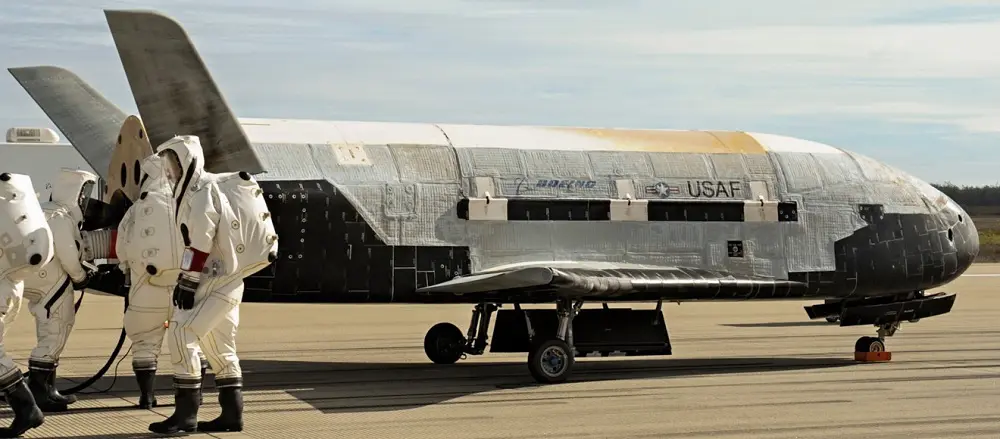
“A Robotic Orbital Spaceplane Boeing X-37. (Source: Boeing, 2014.)”
The current Space Fleet is largely growing from an initial force of Robotic Orbital Spaceplanes, and Spacecraft – Satellites, and potentially Kill Vehicle – Satellites, such as Orbital Anti-Satellite Weapon Systems; that are known to be in development, “[and]… are essentially very early versions of Space warships.” (Mizokami, 2020) The current Space Fleet represent a major assumption about the conduct of a near-future Space-to-Space War, or Space-Base Battle that it will continue with, “the spatial separation of Human combatants from their weaponry.” (Ramey, 2000) A core argument made at the beginning of the Space Warfare Era, was the assumption that a Human pilot crewing a Spacecraft,
“[possessed]… inherent advantages over machines, particularly in terms of on-the-spot judgment and flexibility.” (Sambaluk, 2011)
The fundamental problem is that we are now beginning to envisage a massive surge of Human activity in Space, exploring it, travelling to it, staying and possibly settling on the Earth’s Moon, in large Space Stations, and on Mars. This will require a complete rethink about the role and nature of the Space Fleet – it will have to be Human crewed and operated. For instance, it has been envisaged that a number of specialised Space Force Spacecraft could be built such as a Cislunar Highway Patrol Vehicle, or a Moon-Local Observation-Inspection Spacecraft, with manoeuvre capability (Erwin, 2020; Buehler, 2021).
While the future shape of Military Spacecraft is not known. Some aspects are possible to envisage. It is known, the Spacecraft will play a patrolling and policing role – some will be remotely piloted. The progression of the patrolling and policing role will see a need to be armed with defensive weapons to protect legitimate Space activity. In dealing with Humans in Space, these will need to be crewed by Humans. This process has already begun, as it should be noted currently, there is an actual U.S. Army Astronaut Detachment with a small group of, “Soldier Astronauts” (U.S. Army, 2018). Their role is to support NASA with flight crew members providing engineering expertise for Human interface with Space systems (U.S. Army, 2020).
In the near future, it can be anticipated that the current Spacecraft – which began as Military Satellites, will grow in technical complexity, become larger craft, and be able to accommodate a piloting crew. This has largely been recognised for some years now, as has been noted earlier in this exploratory paper, founded in the Laws of War, the notion of the Astronaut-Combatant is already embedded; as it is envisaged a scenario, where a military uniformed astronaut who enters another nation’s Spacecraft can claim combatant status. The 2020 announcement that personnel in the U.S. Space Force will be called Guardians (Garamon, 2020), was likely chosen to achieve a less military-sounding role, in keeping with the requirement to keep in step with an ongoing demilitarization of Space. The decision nevertheless reflects a posture for the Space Force, to be capable to fight a Space-to-Space War, yet also play an active role as Space Coast Guard, patrolling and policing Low Earth Orbit, Cislunar and Mars Space.
REFERENCES
- REFERENCES
- • Adams, C. 2009 Deterrence: An Enduring Strategy. iUniverse.
• Bahn, P. Kyger, T. 2020 Op-ed: A Space Force Needs Spaceships. Space News (22 January).
• Boeing Corporation. 2014 Photograph. X-37B Orbital Reusable Spaceplane. Landed at Vandenberg Air Force Base (17 October).
• Boushey, H.A. 1958 Lunar Base Vital. Army-Navy-Air Force Register. Number 79 (8 February).
• Buehler, D. Felt, E. Finley, C. Garretson, P. Stearns, J. Williams, A. 2021 Posturing Space Forces for Operations Beyond Geo. Space Force Journal. Issue 1 (31 January).
• Commander, U.S. Pacific Fleet. 2020 USS Portland Conducts Laser Weapon System Demonstrator Test. U.S. Navy Website (22 May).
• Dukowitz, Z. 2017 Out of This World Anti-Drone Technology: Lasers, UTMs, Bullets with Nets, and More. UAV Coach Website (26 July).
• Erwin, S. 2020 Moon Patrols Could be a Future Reality for Space Force. Space News (2 November).
• Flaherty, C. 2020 Inverted Combat in Space. Space & Defence. My Security Marketplace Website (29 September).
• Flaherty, C. 2020 Spherical Tactics in Space. Space & Defence. My Security Marketplace Website (29 September).
• Flaherty, C. 2020 Lunar Surface Combat. Space & Defence. My Security Marketplace Website (29 September).
• Flaherty, C. 2010 Command, Influence and Information in 3D Tactics. Journal of Information Warfare. Volume 9. Issue 1.
• Freedberg, S.J. 2020 A Golden Age for Collaboration on Lasers & Microwaves: But Watch the Cheetos! Breaking Defense Website (7 July).
• Garamon, J. 2020 Space Force Personnel to be Called Guardians. U.S. Department of Defense News (19 December).
• Garcia, M. (Editor) 2017 [-2013] Space Debris and Human Spacecraft. NASA Website (7 August).
• Hambling, D. 2021 The US Army is Building the Most Powerful Laser Weapon in the World. New Scientist (19 February).
• Harper, J. 2019 Special Report: The Pentagon Could Put Directed Energy Weapons in Space. National Defense Magazine (25 April).
• Hart, B.H.L. 1920 The Essential Principles of War. United Services Magazine (April).
• Havercroft, J. Duvall, R. 2009 The Geopolitics of Space Control and the Transformation of State Sovereignty. Bormann, N. Sheehan, M. (Editors) Securing Outer Space: International Relations Theory and the Politics of Space. Routledge Critical Security Studies.
• Janhunen, P. 2021 Terraforming the Dwarf Planet: Interconnected and Growable Ceres Megasatellite World. Elsevier (15 January).
• Keller, J. 2020 Lockheed Martin Continues Integrating 360-Degree Spherical Electro-Optical Avionics Sensor on F-35 Combat Jet. Military & Aerospace (6 January).
• Keller, J. 2020 Here Comes the Army’s First Laser Battalion. Task and Purpose Website (6 August).
• Kubrick, S. Clarke, A.C. 1968 2001: A Space Odyssey. United States: Metro-Goldwyn-Mayer Corporation.• Laporta, J. 2018 Navy Orders Laser Weapon Systems from Lockheed Martin. Space Daily (29 January).
• LeMay, C. 1958 Article for the American Ordnance Association’s Ordnance (7 May). General LeMay, Box B171, LeMay Papers (October 1957 – September 1958). Library of Congress.
• Mizokami, K. 2020 The Space Force Spells Out What Spacepower is all About. Popular Mechanics (17 August).
• NASA. External Vehicle Markings (EVM) Document. NASA Website.
• NASA. 1961 An Artist’s Impression of Dyna-Soar Being Launched Using a Titan Booster, with Large Fins Added to the Titan’s First-Stage. NASA Website.
• National Research Council. 1997 Protecting the Space Station from Meteoroids and Orbital Debris. Washington, DC: The National Academies Press.
• Preston, R. Johnson, D.J. Edwards, S.J.A. Miller, M.D. Shipbaugh, C. 2002 Space Weapons, Earth Wars. RAND Corporation.
• Ramey, R.A. 2000 Armed Conflict on the Final Frontier: the Law of War in Space. The Air Force Law Review. Volume 48.
• Reesman, R. Wilson, J.R. 2020 The Physics of Space War: How Orbital Dynamics Constrain Space-to-Space Engagements. The Aerospace Corporation (October).
• Sambaluk, N.M. 2011 What’s a Heaven For? National Public Culture’s Role in Shaping U.S. Space Policy, Aerospace Doctrine, and the Future of the Dyna-Soar, 1957-61. Dissertation. The University of Kansas.
• Smith, E.E. 1928 The Skylark of Space. Various Publishers. Project Gutenberg.
• Spencer, M. 2020 Directed Energy Weapons: Playing with Quantum Fire. Air Power Development Centre. Commonwealth of Australia (January).
• Team Crane. 2012 UAV Swarm Attack: Protection System Alternatives For Destroyers. Naval Postgraduate School. Capstone Project Report (December).
• Trevithick, J. 2021 Here’s Our Best Look Yet at Russia’s Secretive Space Cannon, the Only Gun Ever Fired in Space. The War Zone (16 February).
• Tsiolkovsky, K.E. 1883 Free space. Manuscript.
• Universal Pictures. 1980 Flash Gordon.
• United Nations. Office for Outer Space Affairs (UNOOSA). Resolution Adopted by The General Assembly 2222 (XXI). Treaty on Principles Governing the Activities of States in the Exploration and Use of Outer Space, Including the Moon and Other Celestial Bodies.
• U.S. Air Force [United States Air Force]. 2020 X-37B Orbital Test Vehicle. Fact Sheet.
• U.S. Army [United States Army]. 2020 United States Army Astronaut Detachment. U.S. Army Space and Missile Defense Command Public Affairs Office.
• U.S. Army [United States Army]. 2018 The Army Has Three Active-Duty Soldier-Astronauts. Mighty Tactical. We Are the Mighty Website (1 November).
• U.S. Army [United States Army]. 1965 The Meanderings of a Weapon Oriented Mind When Applied in a Vacuum Such as on the Moon. Headquarters Weapons Command Rock Island, Illinois (June, 652156).
• U.S. Space Force [Headquarters United States Space Force]. 2020 Space Capstone Publication, Spacepower (June).
• White, T. 1959 Issues Relevant to 1960 Budget Items. Chief of Staff Memos. Box 26. White Papers (28 May). Library of Congress.
• Worden, S.P. Shaw, J.E. 2002 Whither Space Power? Forging a Strategy for the New Century. Fairchild Paper (September).
• Zak, A. 2015 Here is the Soviet Union’s Secret Space Cannon. Popular Mechanics (16 November).
AUTHOR
Chris Flaherty authored the Terrorism Research Center’s report – Dangerous Minds (2012). He was the co-primary author, along with Robert J. Bunker of the book – Body Cavity Bombers: The New Martyrs (iUniverse, 2013). Two essays of his, from 2003 and 2010 were reprinted in the Terrorism Research Center’s book – Fifth Dimensional Operations (iUniverse, 2014). He recently contributed a book chapter – The Role of CCTV in Terrorist TTPs, edited by Dave Dilegge, Robert J. Bunker, John P. Sullivan, and Alma Keshavarz, the book – Blood and Concrete: 21st Century Conflict in Urban Centers and Megacities, a Small Wars Journal anthology, published on behalf of the Small Wars Foundation with Xlibris (2019). Chris Flaherty is currently a Space & Defense Tech and Security News Regular Contributor.
CONTACT DETAILS: Dr Chris Flaherty https://au.linkedin.com/in/drchrisflaherty




